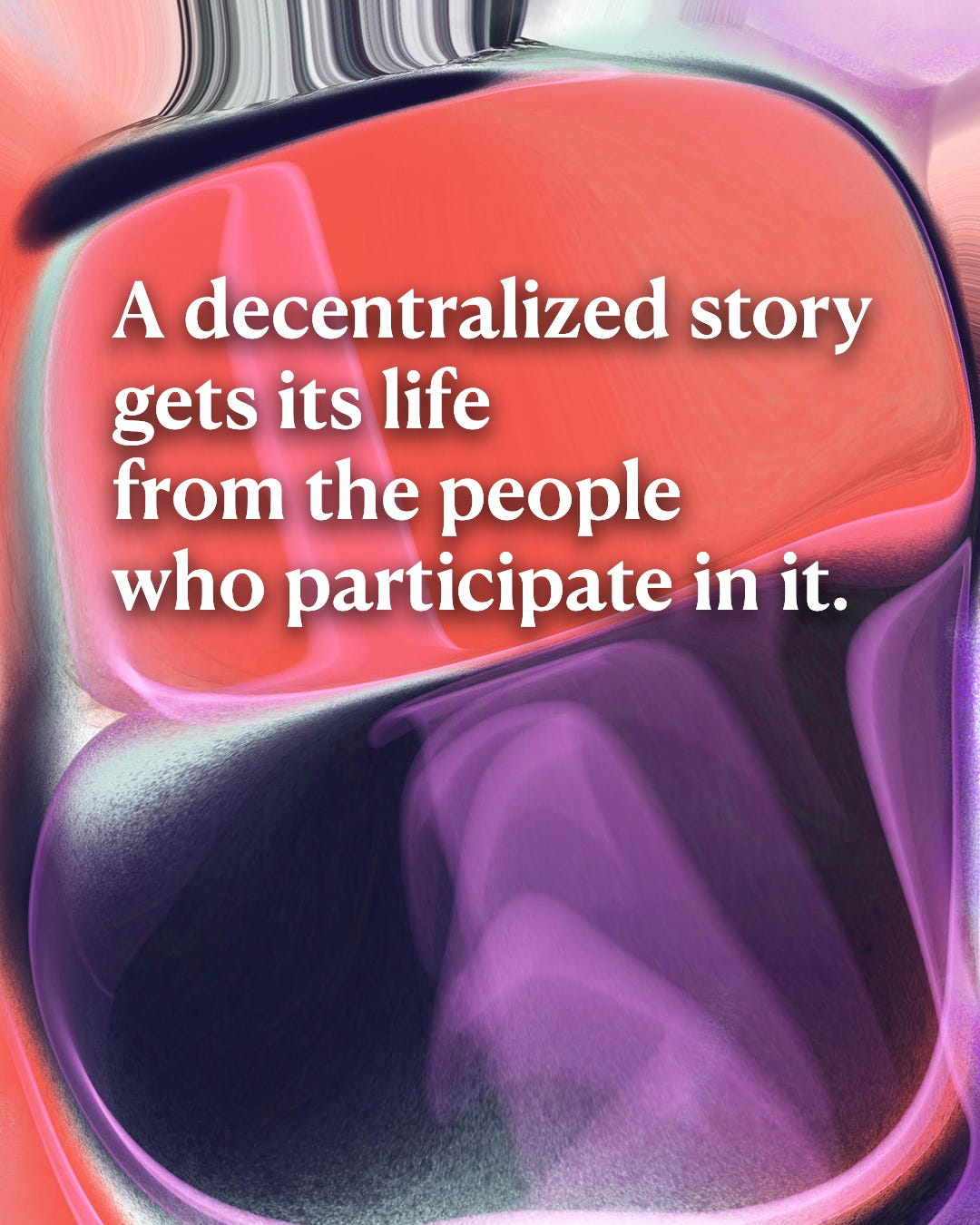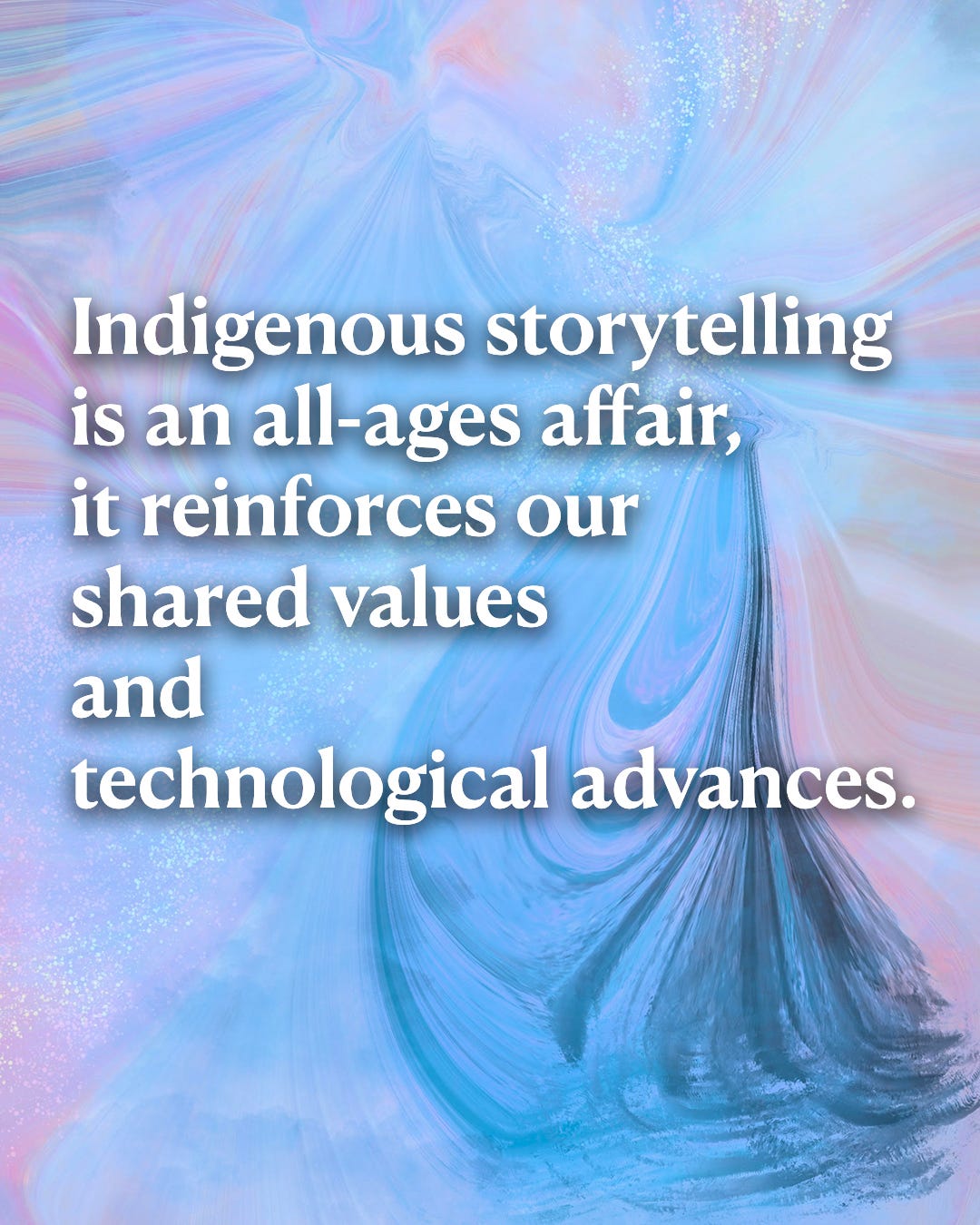Decentralized storytelling, from Native tradition to the metaverse
An interview with Amelia Winger-Bearskin, on turning ideas into rhizomes for future generations
A scholar, artist and hacker, Amelia Winger-Bearskin marries lessons from indigenous cultures with hopes for a human-centered, values-driven digital future.
I first met Amelia when she gave a presentation in 2019 on how Iroquois wampum—a code woven into beads that acts both as currency and contract—prefigured both cryptocurrencies and the US Constitution. Since then, I’ve followed her vital podcast wampum.codes, which features convivial interviews with indigenous technologists about how they’re building digital art, tech, and spaces reflective of Native values.
After she published a fascinating exploration of the history and future of decentralized storytelling, I sat down with Amelia to understand what decentralized storytelling is, why it matters, what virtual worlds can learn from native traditions, and how it might shape our future.
—Eli Pariser, Co-director, New_ Public
Eli Pariser: So let’s start with the basics: What is decentralized storytelling?
Amelia Winger-Bearskin: I grew up as a young hacker in the ’90s, a 12-year-old girl with other 12-year-old girls who were hacktivists. So the dreams of decentralized storytelling, for me, started in those early days when I was first learning about the internet—when I’d go to school, and only one or two people at my whole school were online. And we would have these other lives, not just with our local friends but with people all over the world, some of whom we knew nothing about except their username.
But I’m Seneca-Cayuga Nation of Oklahoma, Deer Clan, which is a member of the six-nation Haudenosaunee—other people know us as the Iroquois. And we have a storytelling tradition that I believe is also decentralized storytelling.
My mom is a traditional storyteller from our tribe. Being a storyteller for the Seneca-Cayuga Nation is something that is a cross between being a historian, being a performer, being a creative writer, and being a leader within the culture.
So you need to be given the stories from elders and have the reputation to be able to receive them. But the understanding is that you’re not going to just tell the story the exact same way that the elder who gave it to you would. You’re supposed to add your own creativity, you’re supposed to add your own perspective, and you’re supposed to make it relevant to the generation that you’re telling it to. You’re an interpreter, but you’re also a repository of information.
The way we tell our stories, key aspects of the stories are embedded within the landscape: “this is a story of Bear Mountain,” or embedded in handicrafts, like “this is the story of the cornhusk doll,” or the stories are actually told through song, or through design, or through imagery within basket weaving, or raised beadwork.
Telling stories across multiple media is a strategy to make sure that your ideas become like a rhizome—they become sticky, and accessible to many generations. You have to make sure you can distill your information into a clear abstraction, and then embed it in as many ways as you can. So, if you’re a young child, and you only have a short amount of time with a storyteller, who may only pass through your village for a short period of time, and that storyteller tells you the story of a mountain that you see every day as you walk along and have adventures with your friends, that story will remain in your memory better. And that story may have scientific information around planting, around seasons, might have information around the stars—the scientific advances and discoveries that people generations before you have made.
Why is decentralized storytelling important for all of us, as a way of doing things, as a practice?
I think it’s important in two ways.
One, it’s about future-proofing some of our core values for the seven generations to come. If we want to leave some of the insights from our ancestors that we are responsible for holding for future generations—I think it’s smart for us to build them into a decentralized format. That way we have them distributed in ways that are not just left to a monolithic interpreter, which is assuming that people in the future will understand what they need to understand through books, or films, or whatever is the archive that we imagine will be the storytellers to the future.
And the second reason is, this new generation already is very fluent in decentralized storytelling, and they want to participate in stories, game worlds, and creative narratives more than they want to be told what to discuss through centralized media formats. So if you’re interested in engaging with that generation, I think it is really necessary to understand the core aspects of decentralized storytelling.
I think we can learn a lot from young people around ways in which they use spaces and break spaces. They have the constraints that most young people have, which is they have tons of time, and they don’t have a lot of money, so they end up reusing outdated technology in really innovative and creative ways as well.
Decentralized storytelling involves a lot of skill and creativity. How about rules and responsibility?
Absolutely. We see that in a lot of game worlds, right? When I first started to get involved in the world of Minecraft with my son, I felt like, “This is just really open, what are you supposed to do?”
And he said, “Well, when you sign into the server, they will welcome you. And then they’ll tell you the rules, they’ll tell you what they’re doing. Like, right now we’re building this giant forest.”
So I think we’re seeing those protocols written out quite explicitly in game worlds. And yet, we’re still having difficulty in some consumer software for social networks to make those same kinds of things explicit. We do know it creates a lot of burden on moderation and governance, which as humans we’ve been struggling with in the real world, just like virtual space.
What do you wish that game world creators would learn from Native traditions of indigenous storytelling? What are the pieces that they most often miss?
I do like that right now we have games and story spaces that take a long time to tell. Maybe a game could be 24 or 32 hours in player time, or longer if it’s an open world format, where people may go back again and again in order to just sort of hang out in the story world. I think that’s really beautiful.
In a similar way, in my tribe, a story can be told every night for a winter, or for six hours at a day, and you come back the next day, it’s another six hours, and you don’t actually ever hear the “end” of the story, because it goes on. It becomes part of your life. I think that has a very ancient and grounding quality to it.
But I think that indigenous protocol understands the value of each member—that their participation in the culture is absolute. People are not left out or left aside as quickly as I see in the gaming community. There still is not yet a design that allows people to have true safety within online spaces. I do think we’re close to being able to figure that out from a technological point of view. But it has to start being important to the people who are creating games that every member of their community feels safe and can participate in the same way.
For me that raises this question about scale. Do you see a tension between the size of an online story space, and whether people within it feel empowered to participate?
I recommend people check out the reporting over the years about EVE Online. Many social scientists have written papers about the communities that have evolved through many years of playing with thousands and thousands of members.
I was doing a talk recently at Sundance Film Festival with the creative director of EVE Online. And he said, when he created this game, he would feel like a god creating a world. But now he just feels like a janitor, because the players are like, we demand this, we’ve organized and we voted. The players created their own tribunals, their own governance, and then they have their own systems of protests that they will do if they don’t like changes.
So I think EVE Online is a really good example of a governance structure that truly cares about justice within their very massive multiplayer system.
Underneath what we’ve been talking about is a question about the economic models of storytelling. I’ve been thinking about the Marvel Cinematic Universe, which is a massive, centralized universe all built around Disney’s IP ownership stake, and its contracts with various actors and so forth. How do the economics of storytelling shape the kinds of stories that get told?
In the model you just mentioned, people have consolidated IP, splintered it into fragments and then shot it out to more locations, to make even more money for the centralized entity. That’s the way in which we have seen IP traditionally gain value.
But as an audience member, or as a creator, or participant, I don’t see the younger generation being as excited about consuming more and more splintered nodes of primary IP in millions of different formats.
I see them being more excited about participating. They’d rather see a video from someone like themselves, or rehash that meme and make their own meme comp and then follow this other person who makes another meme comp. There are a lot of exceptionally low-fidelity, low-quality deep-fried rehash meme comps that are so much more interesting and relevant to the people of their generation. They’re just cleaning the clock of traditional media in terms of relevance, and interest, and how unique and funny they are.
We can continue to just say, we have to make money in the same ways that we’ve made it previously. Because we can’t imagine sharing. Or the next generation can find a way to communicate to older generations that they have to release the stranglehold on power, when it comes to storytelling. I’m rooting for the next generation.
What are your hopes for future generations?
I hope that we have stories that contain our values, that are based on caring for one another, a deep understanding of each other’s experience. And I hope that we’re able to both see more of ourselves in the stories that we listen to, and also feel empowered to be storytellers in everything that we do. 🌳
Amelia Winger-Bearskin is an artist who innovates with artificial intelligence to bring positive outcomes for our land (turtle island). She is a Banks Preeminence Chair and Associate Professor of Artificial Intelligence and the Arts, at the Digital Worlds Institute at the University of Florida.
Eli Pariser is an author, activist, and entrepreneur focused on how to make technology and media serve democracy. He helped lead MoveOn.org, co-founded Avaaz.org (now the world’s largest citizen’s organization), wrote the 2011 bestseller The Filter Bubble, and co-founded Upworthy. He is currently Co-director of New_ Public at the National Conference on Citizenship.
Design by Josh Kramer. Story images by Amelia Winger-Bearskin.
Public domain images of wampum and wampum-making tools are from the National Museum of the American Indian.






